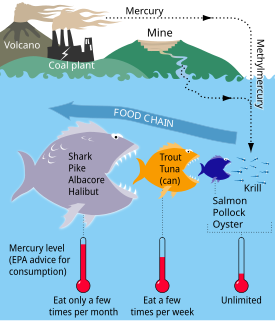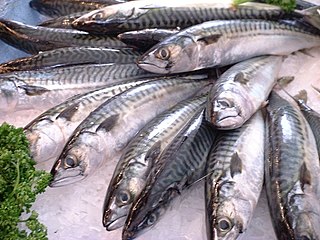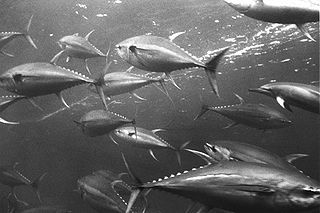
Seafood is any form of sea life regarded as food by humans, prominently including fish and shellfish. Shellfish include various species of molluscs, crustaceans, and echinoderms. Historically, marine mammals such as cetaceans as well as seals have been eaten as food, though that happens to a lesser extent in modern times. Edible sea plants such as some seaweeds and microalgae are widely eaten as sea vegetables around the world, especially in Asia. In North America, although not generally in the United Kingdom, the term "seafood" is extended to fresh water organisms eaten by humans, so all edible aquatic life may be referred to as "seafood". For the sake of completeness, this article is inclusive of all edible aquatic life.

A tuna is a saltwater fish that belongs to the tribe Thunnini, a subgrouping of the Scombridae (mackerel) family. The Thunnini comprise 15 species across five genera, the sizes of which vary greatly, ranging from the bullet tuna up to the Atlantic bluefin tuna. The bluefin averages 2 m (6.6 ft), and is believed to live up to 50 years.

The mahi-mahi or common dolphinfish is a surface-dwelling ray-finned fish found in off-shore temperate, tropical, and subtropical waters worldwide. Also widely called dorado and dolphin, it is one of two members of the family Coryphaenidae, the other being the pompano dolphinfish. These fish are most commonly found in the waters around the Gulf of Mexico, Costa Rica, and Hawaii

Swordfish, also known as broadbills in some countries, are large, highly migratory, predatory fish characterized by a long, flat bill. They are a popular sport fish of the billfish category, though elusive. Swordfish are elongated, round-bodied, and lose all teeth and scales by adulthood. These fish are found widely in tropical and temperate parts of the Atlantic, Pacific, and Indian Oceans, and can typically be found from near the surface to a depth of 550 m (1,800 ft). They commonly reach 3 m (9.8 ft) in length, and the maximum reported is 4.55 m (14.9 ft) in length and 650 kg (1,430 lb) in weight.

Bacteriological water analysis is a method of analysing water to estimate the numbers of bacteria present and, if needed, to find out what sort of bacteria they are. It represents one aspect of water quality. It is a microbiological analytical procedure which uses samples of water and from these samples determines the concentration of bacteria. It is then possible to draw inferences about the suitability of the water for use from these concentrations. This process is used, for example, to routinely confirm that water is safe for human consumption or that bathing and recreational waters are safe to use.

Scombroid food poisoning, also known as simple scombroid, is a foodborne illness that typically results from eating spoiled fish. Symptoms may include flushed skin, headache, itchiness, blurred vision, abdominal cramps, and diarrhea. Onset of symptoms is typically 10 to 60 minutes after eating and can last for up to two days. Rarely, breathing problems or an irregular heart beat may occur.
A bromide is a chemical compound containing a bromide ion or ligand. This is a bromine atom with an ionic charge of −1 (Br−); for example, in caesium bromide, caesium cations (Cs+) are electrically attracted to bromide anions (Br−) to form the electrically neutral ionic compound CsBr. The term "bromide" can also refer to a bromine atom with an oxidation number of −1 in covalent compounds such as sulfur dibromide (SBr2).

Many species of fish are consumed as food in virtually all regions around the world. Fish has been an important source of protein and other nutrients for humans throughout history.
Indicator bacteria are types of bacteria used to detect and estimate the level of fecal contamination of water. They are not dangerous to human health but are used to indicate the presence of a health risk.
Pathatrix is a high volume recirculating immuno magnetic-capture system for the detection of pathogens in food and environmental samples. Pathatrix was used in 2006, linking an E. coli O157 outbreak to contaminated spinach.
Got Mercury? is a public awareness campaign about mercury levels in seafood. It is sponsored by the Sea Turtle Restoration Project (STRP) and its parent organization, the Turtle Island Restoration Network (TIRN). The name of the campaign is a snowclone of the successful Got Milk? advertising campaign.

Fish and shellfish concentrate mercury in their bodies, often in the form of methylmercury, a highly toxic organomercury compound. Fish products have been shown to contain varying amounts of heavy metals, particularly mercury and fat-soluble pollutants from water pollution. Species of fish that are long-lived and high on the food chain, such as marlin, tuna, shark, swordfish, king mackerel and tilefish contain higher concentrations of mercury than others.

Mahi-mahi are swift and acrobatic game fish with striking colours. These colours darken when the fish dies The current IGFA all tackle record is 39.91 kilograms (88lb), caught in 1998 in Exuma, Bahamas by Emily Seconi of Aiken, South Carolina. Catches average 7 to 13 kilograms, and any mahi-mahi over 18 kilograms (40 lb) is exceptional. Males are often larger than females.

Raw meat generally refers to any type of uncooked muscle tissue of an animal used for food. In the meat production industry, the term ‘meat’ refers specifically to mammalian flesh, while the words ‘poultry’ and ‘seafood’ are used to differentiate between the tissue of birds and aquatic creatures.
PCR food testing is the engagement of Polymerase Chain Reaction (PCR) technologies for the testing of food for the presence or absence of human pathogens, such as E. coli, Salmonella, Listeria, etc.
Applied Food Technologies, Inc. (AFT) is a privately held corporation in Alachua, Florida that develops diagnostics needed in the seafood industry and runs fee-for-service species identification and verification programs. The DNA-based species identification diagnostics developed by AFT are used in-house and are also packaged in a kit format and sold to federal, state and private laboratories in the US, Europe and Asia. AFT has established an extensive library of taxonomically verified fish species and has developed DNA standards for these fish.

Mackerel is an important food fish that is consumed worldwide. As an oily fish, it is a rich source of omega-3 fatty acids. The flesh of mackerel spoils quickly, especially in the tropics, and can cause scombroid food poisoning. Accordingly, it should be eaten on the day of capture, unless properly refrigerated or cured.

Seafood species can be mislabelled in misleading ways. This article examines the history and types of mislabelling, and looks at the current state of the law in different locations.
Antimicrobials destroy bacteria, viruses, fungi, algae, and other microbes. The cells of bacteria (prokaryotes), such as salmonella, differ from those of higher-level organisms (eukaryotes), such as fish. Antibiotics are chemicals designed to either kill or inhibit the growth of pathogenic bacteria while exploiting the differences between prokaryotes and eukaryotes in order to make them relatively harmless in higher-level organisms. Antibiotics are constructed to act in one of three ways: by disrupting cell membranes of bacteria, by impeding DNA or protein synthesis, or by hampering the activity of certain enzymes unique to bacteria.



















